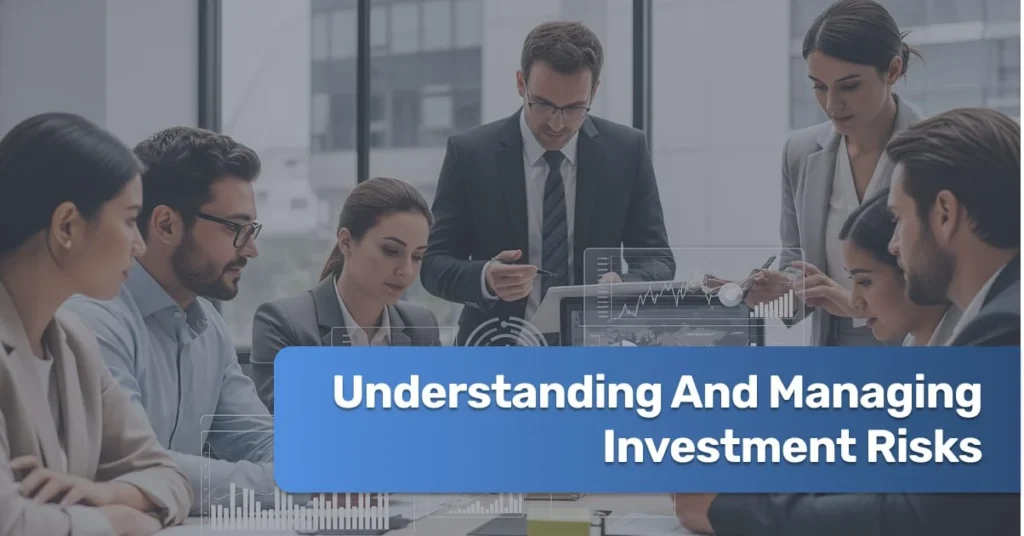Investing offers the potential for financial growth, but every investment comes with some level of risk. Whether you’re new to investing or looking to refine your strategy, understanding and managing investment risks is essential for long-term success. This guide breaks down the different types of investment risks, explains their impact on portfolios, and offers practical strategies to mitigate them.
What Is Investment Risk?
Investment risk refers to the possibility that an investment’s actual return will differ from the expected return, potentially resulting in a loss of capital. Risk is an inherent part of investing, and it cannot be eliminated entirely. However, it can be understood, measured, and managed.
Key takeaway: Understanding risk helps you make smarter, more informed investment decisions.
Types of Investment Risks
1. Market Risk
Also known as systematic risk, market risk arises from broad economic or political events that affect the entire market. These can include inflation, interest rate changes, recessions, or global conflicts.
Example: A financial crisis, like the 2008 recession, causes stock prices across the board to decline.
2. Credit Risk (Default Risk)
This is the risk that a bond issuer or borrower may fail to meet their obligations. Credit risk is most relevant for fixed-income investments like bonds and P2P lending.
Example: Investing in a corporate bond from a company that later declares bankruptcy.
3. Liquidity Risk
Liquidity risk arises when you’re unable to quickly buy or sell an investment without a significant price impact. This is common in real estate crowdfunding or alternative assets.
Example: A property investment via a crowdfunding platform might take months to sell if you need cash urgently.
4. Currency Risk (Exchange Rate Risk)
This affects investors holding foreign assets. Fluctuations in exchange rates can impact returns, especially for European investors placing capital outside the Eurozone.
Example: Investing in U.S. stocks while the Euro strengthens may reduce your return when converted back.
5. Inflation Risk
This refers to the erosion of purchasing power over time. If your investments do not outpace inflation, the real value of your returns diminishes.
6. Interest Rate Risk
Most relevant to bondholders, this risk means that bond prices fall when interest rates rise.
Example: If interest rates rise, older bonds with lower yields become less attractive, reducing their market value.
7. Political and Regulatory Risk
Changes in government policies, regulations, or tax laws can impact investments significantly.
Example: The European Union introducing stricter rules on crowdfunding platforms.
How to Measure Investment Risk
1. Standard Deviation
This statistical measure shows how much an investment’s returns deviate from its average return. A high standard deviation indicates higher volatility.
2. Beta
Beta measures an investment’s volatility relative to the market. A beta above 1 means the asset is more volatile than the market.
3. Sharpe Ratio
This tells you how much excess return you are receiving for the extra volatility you endure for holding a riskier asset.
Managing and Mitigating Investment Risks
1. Diversification
Don’t put all your eggs in one basket. Spread your investments across asset classes (stocks, bonds, real estate, P2P loans) and geographies.
Tip: Consider diversifying with alternative investments in Europe like green energy crowdfunding or micro real estate investments.
2. Understand Your Risk Tolerance
Every investor has a different capacity for risk depending on age, income, goals, and financial responsibilities. Take a risk assessment before building your portfolio.
3. Use Dollar-Cost Averaging
This strategy involves investing a fixed amount regularly, regardless of market conditions, which helps average out the cost and reduce timing risk.
4. Invest in Low-Cost Index Funds or ETFs
These funds provide diversification and typically carry lower risk due to broad market exposure.
5. Keep a Long-Term Perspective
Markets fluctuate in the short term. A long-term strategy helps ride out volatility and reduces panic-driven decisions.
6. Monitor Your Portfolio Regularly
Adjust allocations in response to changing financial goals or market conditions, but avoid overreacting to short-term movements.
Visual Aid: Risk vs Return Chart by Asset Type
| Asset Class | Risk Level | Potential Return |
|---|---|---|
| Government Bonds | Low | Low |
| ETFs/Index Funds | Moderate | Moderate |
| Individual Stocks | High | High |
| Real Estate | Moderate | Moderate to High |
| P2P Lending | High | High |
| Cryptocurrencies | Very High | Very High |
Investment Risk Examples in 2025
- AI startup collapses after hype fades – example of sector-specific market risk.
- Fraudulent crypto wallet platform shuts down – example of credit and regulatory risk.
- German property crowdfunding platform delays payouts – liquidity risk in real estate crowdfunding.
Conclusion: Risk Is Not the Enemy, Ignorance Is
Investment risk is not something to fear, but something to understand and manage. The most successful investors are not the ones who avoid risk completely, but the ones who recognize it and make informed choices.
By diversifying, understanding your own tolerance, and staying informed about the market and economic trends, you can build a resilient portfolio that aligns with your financial goals.
FAQ: Understanding and Managing Investment Risks
The main risks include market risk, credit risk, liquidity risk, inflation risk, and operational or regulatory risks
Consider your financial goals, time horizon, comfort with potential losses, and your overall financial situation
Diversifying your portfolio, balancing asset allocation, regularly reviewing investments, and using risk-mitigation tools like hedging are effective strategies
Diversification spreads your investments across different assets, reducing the impact of any single underperforming investment
You should review your investment risks at least once a year or after major financial or life changes
You can use tools like risk profiling questionnaires, financial software, and professional advice to monitor and manage risk
Asset allocation helps align your investment mix with your risk tolerance and goals, balancing growth potential and stability

